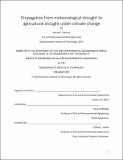Propagation from meteorological drought to agricultural drought under climate change
Author(s)
Gannon, Meriah J.
DownloadThesis PDF (3.683Mb)
Advisor
Entekhabi, Dara
Terms of use
Metadata
Show full item recordAbstract
Persistent precipitation deficits, or meteorological droughts, often but not necessarily lead to persistent soil moisture deficits, also known as agricultural droughts. For the same amount of accumulated precipitation deficit, an agricultural drought may or may not be triggered depending on a number of catalytic co-factors. In this study we use satellite observations to quantify how coincident warm temperature anomalies makes the transition from one drought type to another to occur more frequently. We then show that climate model historical simulations correctly capture this phenomenon. Finally, we show that future climate simulations reveal a marked intensification of the drought propagation from one type to another. With this intensification under climate change, equal precipitation deficits can cause a greater decrease in soil moisture and hence more severe agricultural droughts. We find that elevated temperatures nearly always exacerbate agricultural drought for a given precipitation deficit across multiple models, and future agricultural droughts are likely to be more extreme across the Americas, Europe, and Australia. Projected precipitation increases appear to offset heating amplification of agricultural drought in Africa and southern Asia, but not in North America or Europe. This underscores that changes in precipitation alone are insufficient for estimating drought propagation to soil moisture that is the pathway to impacts on crops and natural ecosystems, and water resources (e.g., aquifer recharge).
Date issued
2023-02Department
Massachusetts Institute of Technology. Department of Civil and Environmental EngineeringPublisher
Massachusetts Institute of Technology